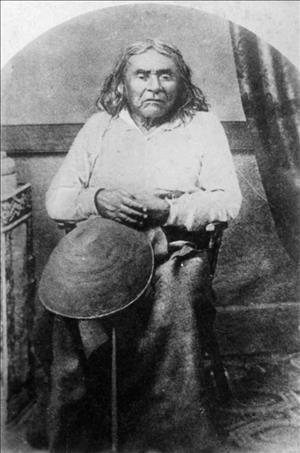The Oregon Territorial Legislature created King County out of Pierce County on December 22, 1852. Colonel Isaac N. Ebey (1819-1857), a delegate to the Oregon Legislature from Whidbey Island, introduced the bills that created and named King, Pierce, Jefferson, and Island counties. King County's seat was located at Seattle on the land claim of Dr. David S. Maynard (1808-1873). The county was originally named to honor William R. King (1786-1853) of Alabama, a former U.S. diplomat, U.S. Senator, and Vice President.
Native Land
Before the arrival of Europeans, much of King County was the realm of the Duwamish and Suquamish, tribes that belonged to the community of Puget Sound Salish, or Lushootseed-speaking peoples. Except for occasional raids by warriors or slavers from North Coast tribes, they lived a peaceful and culturally rich existence blessed with abundant fish and game and a mild, if damp, climate. Visitations by European explorers in the late 1700s brought to these tribes the first of several catastrophic epidemics. In Western Washington a measles epidemic in 1848 and a smallpox epidemic in 1853 resulted in massive numbers of deaths in indigenous villages. Europeans began settling on the Duwamish River near present-day Seattle in 1851. The devastation of indigenous populations contributed to a white majority by 1858.
Following European settlement, on December 22, 1852, the Oregon Territorial Legislature created King County. King County was carved out of the northern part of Oregon Territory's Pierce County, and was the fourth Oregon county organized north of the Columbia River. Colonel Isaac N. Ebey (1819-1857), a delegate to the Oregon Legislature from Whidbey Island, introduced the bills that created and named King, Pierce, Jefferson, and Island counties. King County's seat was located at Seattle on the land claim of Dr. David S. Maynard (1808-1873).
William Rufus de Vane King
The county was originally named to honor William Rufus de Vane King (1786-1853), a prominent politician at the time. King, a North Carolinian who settled in Alabama, had served as U.S. minister to Naples, St. Petersburg, and Russia, as U.S. Senator from Alabama, President Pro Tem of the U.S. Senate, and very briefly as Vice President. In his last office he served as the running mate of Franklin Pierce (1804-1869), took the Vice Presidential oath of office while in Havana, Cuba, and then died before he could return to the capital. (In 1986, the King County Council voted to name King County after civil rights icon Dr. Martin Luther King Jr. [1929-1968]; the renaming became official in 2005 when the state legislature passed a law renaming the county in honor of Martin Luther King.)
Seattle dominated King County, then as it has since, thanks initially to the decision of Henry Yesler (1810-1892) to locate Puget Sound's first steam-powered sawmill in the village of Duwamps (later renamed Seattle). Most sailing ships and steamers stopped in Seattle, the region's mail was distributed from the little town, and county residents cast their ballots in Seattle, initially at the home of Dr. Maynard. Maynard's land claim was also used as the county seat. Seattle residents Arthur Denny (1822-1899) and Luther Collins (1813-1860) constituted the first board of county commissioners. John Low (1820-1888) was asked to serve as a commissioner, but declined. Other Seattleites helped inaugurate county business: Carson Boren (1824-1912) was appointed sheriff, and Henry Yesler became probate clerk and auditor.
New arrivals in 1852 and 1853 required Denny, Boren, and Maynard to survey the Seattle townsite beginning with their own holdings. On May 23, 1853, two plats were filed with the county auditor.
Tangled Streets
Because of a spat between Maynard and Denny, whose claims abutted along Mill Street (now Yesler Way), the streets did not mesh. Maynard oriented his southern street grid strictly according to the compass. Denny oriented the streets in his northern tract toward the shoreline. Denny later claimed that Maynard, "stimulated" on liquor, had decided, "he was not only monarch of all he surveyed, but what Boren and I surveyed too." The dispute survives today in the tangle of mismatched streets at Yesler Way.
The Columbia, published farther south in tiny Olympia, served as the first newspaper for the area. Not until the fall of 1863 was a local King County news sheet (Seattle Gazette) produced. Because of this 10-year delay in the publication of a local newspaper, contemporary historical, social, and legal records appear in Olympia, Steilacoom, and Port Townsend newspapers.
Charles Terry (1830-1867) opened the first King County store, called the "New York Cash Store," at Alki Point in November 1851. Terry was from New York, and named the place "New York." It was later renamed Alki. ("Alki" means "Bye and Bye" in Chinook jargon.) Alki Point, located in present-day West Seattle, was for years a separate community from Seattle and from the Duwamish Valley.
On the Map
King County residents celebrated their first Fourth of July celebration at Alki in 1853. It consisted of the usual oratory, an outdoor dinner, a reading of the Declaration of Independence, and a dance.
After King County was established, the Organic Act establishing the Territorial Government of Washington was signed by President Millard Fillmore (1800-1874) on March 2, 1853. Franklin Pierce assumed the presidency two days later and appointed Isaac Ingalls Stevens (1818-1862) as governor of the new territory. An 1853 census indicates that King County had 170 non-Indian inhabitants. That year's total non-Indian Territorial population came to 3,965, with Clark County (Fort Vancouver) at 1,134, and Pierce County at 513. After the first shipments of locally milled spars, pilings, shingles, sawed lumber, and cordwood left Yesler's Wharf for San Francisco in 1853, Seattle and King County ceased being secrets to the outside world.

